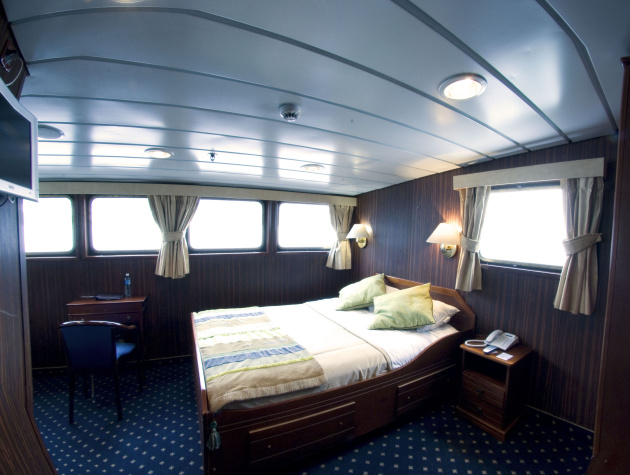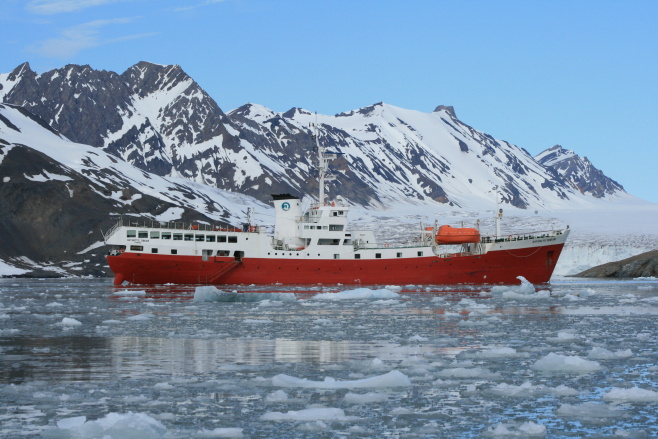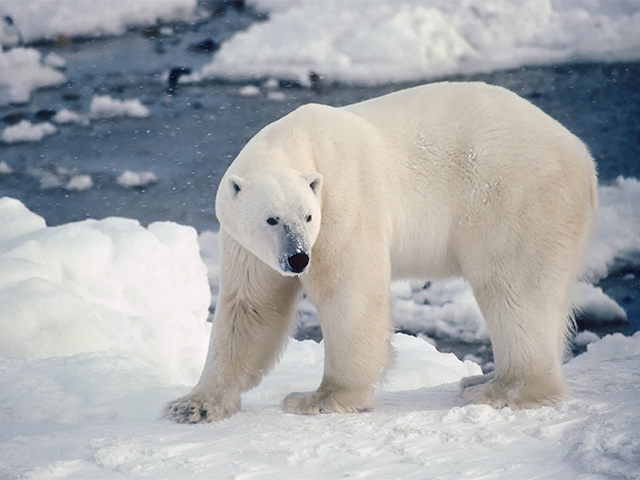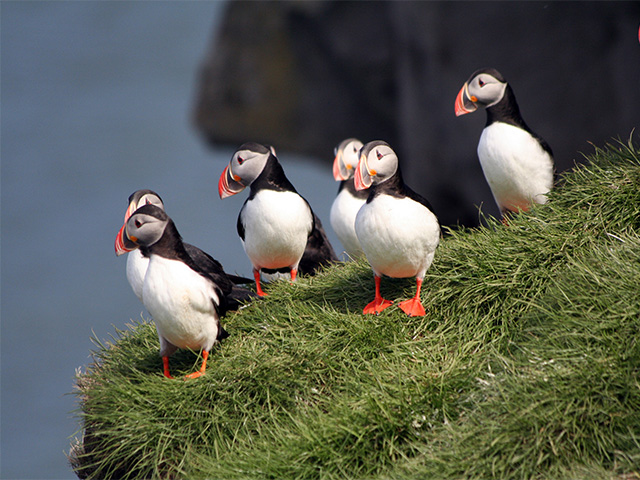- 1Longyearbyen, Norway
On the first day of the cruise, we board the M/v "Antarctic Dream" , a vessel that can accommodate 84 passengers in 42 twin cabins. For the next nine days this vessel will serve as both our accommodation as well as a means of transportation across blue waters!!
Note: This special voyage is dedicated to an intense experience exploring nature in remote areas. We offer full-day hikes to discover the rarely visited interior of various islands. These areas have reindeers and polar bears as visitors, rather than man! We also offer shorter excursions in the same areas.
Spitsbergen is an Arctic archipelago about 650 kilometers (400 miles) north of Norway. The archipelago ranges from Bear Island (74 degree N) to Rossøya (81 degree N). It is by far the largest wilderness area of Europe. It covers an area of about 62,500 square kilometers, which is roughly the size of Ireland. About 60% of the land is glaciated. As Spitsbergen lies far within the Arctic circle, it experiences the midnight sun from April to August. At this time of year the sun is above the horizon for 24 hours a day!
Since 1925, Norway has sovereignty over Spitsbergen according to the international Spitsbergen Treaty. The Norwegian name for the archipelago is Svalbard. The name Spitsbergen was given by the Dutch explorer Willem Barentsz. The meaning of the name Spitsbergen in the Dutch language is "Jagged Peaks" because of the sharp pointed mountains that Barentsz met in the north-west of Spitsbergen. Spitsbergen, which has a population of about 3000 in 4 settlements, is to this day virtually an unspoilt wilderness. Imagine a place the size of Ireland with only about 50 kilometers (30 miles) of road!
Meals: DinnerAccommodation: M/v "Antarctic Dream" - 2Krossfjorden to Blomstrand
Heading north along the west coast, we arrive by morning in Krossfjorden, where we go on zodiacs (small inflatable boats that have a capacity of around ten to eleven passengers) for a cruise along the sculpted front of the 14th July Glacier. On the green slopes near the glacier, a wide colorful variety of flowers bloom, while large numbers of Kittiwakes and Brünnich’s Guillemots nest on the nearby cliffs. Look out for Arctic Foxes, patrolling the base of the cliffs, and Bearded Seals, cruising this fjord! In the afternoon we sail to Blomstrand. Here we climb to the top of the island, to obtain a splendid view across the strait, where until a few years ago a glacier connected the island with the mainland.
Meals: Breakfast, Lunch, DinnerAccommodation: M/v "Antarctic Dream" - 3Liefdefjorden
In Bockfjord, visitors interested in long hikes can set off for a day’s hike to the warm springs about 8 kilometers inland. The walk will take you along glaciers and a volcano in one of the warmest areas in Spitsbergen in the summer. As an alternative, we offer short walks as well to the ones who would prefer a moderate walking experience. Visitors opting for shorter walks get to explore warm springs along the coast in the morning and a lagoon on the spectacular Red Sandstone of Woodfjord, which derives its name from the immense number of logs washed ashore.
In the evening, we sail to the Monaco Glacier in Liefdefjord. The waters of the glacier front are a favorite feeding spot for thousands of Kittiwakes and occasionally Polar Bears are also seen on the glacier. Liefdefjord, a deep fjord in the far north-west, is appropriately named after a Dutch whaling ship with the name \"Love\". This is because this particular fjord has a remarkable red color due to red sedimentary sandstones. You get to witness great scenery and large glacier fronts, in addition to seeing lots of bird life, Bearded Seals, Polar Bears, Minke Whales and Belugas here!
Meals: Breakfast, Lunch, DinnerAccommodation : M/v "Antarctic Dream" - 4Lågøya, Norway to Nordaustlandet
On day four, we will visit Laagøya, a low island with a big lagoon, where a big herd of Walruses tends to congregate. Sabine’s Gulls nest on the island as well. Next, we reach our northernmost point at Phippsøya, in the Seven Islands north of Nordaustlandet. Here we will be at 81 degrees north, just 540 miles from the geographic North Pole. Polar Bears inhabit this region, along with Ivory Gulls. We may sit for several hours in the pack-ice, absorbing the spectacular landscape surrounding us and, after catching sight of a Bear or two, we can turn south again.
Nordaustlandet (North-East Land) is the biggest island in the far north of Spitsbergen. Most of its surface is covered by a huge ice-cap. The ice-front of this ice-cap extends along the coast for about 150 kilometers. Nordaustlandet is completely uninhabited and is a nature reserve. In the coastal regions of Nordaustlandet and its adjoining islands, there is a great deal of Arctic wildlife. Here you can experience the real High Arctic, along with catching sight of Ivory Gulls, Arctic Foxes, Bearded Seals, Ringed Seals, Walruses, Polar Bears, Minke Whales and Belugas.
Meals: Breakfast, Lunch, DinnerAccommodation: M/v "Antarctic Dream" - 5Hinlopen Strait
Today we sail into the Hinlopen Strait. Hinlopen Strait separates the two largest islands of Svalbard, Spitsbergen and Nordaustland. Hinlopen Strait is sometimes a bottleneck because of the pack-ice which can clog up the strait. On the pack-ice and around the islands in the strait there is a good chance of seeing Polar Bears, Walruses and Whales. Even the elusive Bowhead Whale is sometimes seen here!
Afterwards, in Palanderbukta, surrounded by glacier fronts, we set foot on Nordaustland. We will explore the desert-like, yet beautiful environment, of the area. The hikers will follow Palanderdalen, an ice-free corridor between two major ice-caps of Nordaustland. After about 20 kilometers of polar desert, Augustabukta is reached, where an ascent on the ice-cap is easy. Walking in Augustabukta, a lovely bay close to a glacier, is trouble-free as the glacier is without any crevasses. On the tundra we usually see a lot of Reindeer. Both the landings—at Palanderbukta and Augutabukta—will be done without the long hike. One can see a large herd of Walruses, nearby, on Torrellneset.
Meals: Breakfast, Lunch, DinnerAccommodation: M/v "Antarctic Dream" - 6Negribreen to Agardhfjell
The east coast of West-Spitsbergen is very rarely visited during the summer. Today, we will sail along Negribreen one of the rare shelf-ice glaciers in the Arctic. At Teistpynten, near Mohnbukta we will go on a stroll along the coast and on the tundra. On this walk you are most likely to see Reindeers and a spectacular view of the front portion of Negribreen. Some of the Mesozoic sediment layers in this area are very rich in fossils such as ammonites and bivalves. During mid-day, the ship repositions further south to Agardhfjell. There is a possibility to indulge in an excursion, which involves a 5 hour inland walk to a colony of Ivory Gulls!
- Alternatively we offer-
As an alternate plan, we could sail to Sundneset at the Southeastern corner of Barentsøya. This region is blessed with lush tundra vegetation and often homes large numbers of Reindeer. Following a river up to a waterfall, the hikers will cover about 17 kilometers, in order to be rewarded with a splendid view of the landscape. In addition to the rich tundra, waterfall and encountering Reindeers, an alternate plan (which would involve a shorter landing at Sundneset) would include an excursion at Rindedalen on the south side of Barentsøya.
Barentsøya was named after the Dutch navigator Willem Barentsz. The island is situated south-east of the main island. Barentsøya is separated from the mainland by a couple of narrow seaways, including the spectacular Heleysundet. About 100 kilometers (60 miles) to the east of Barentsøya are the Kong Karls Islands. These islands, which are closed off for visitors, are main denning areas for Polar Bears. The pack-ice delivers large numbers of bears from the Kong Karls Islands to Barentsøya and also to Edgeøya. That is why these islands are particularly good for spotting Polar Bears. Besides Polar Bears one may spot many species of birds, as well as Arctic Foxes, Reindeers and Belugas.
Meals: Breakfast, Lunch, DinnerAccommodation: M/v "Antarctic Dream" - 7Diskobukta to Kapp Lee
Day seven sees us in Diskobukta, which lies a good 20 kilometers further southeast (Diskobukta is located on the west side of Edgeøya). Here, we find a small canyon with a colony of Kittiwakes. Kapp Lee, near the north-western corner of Edgeøya, has been a focal point for hunting and scientific expeditions for centuries. Land uplift, that followed the ice-age, left its trace far from the coast, in the shape of ancient whalebones and driftwood (several 1000 years old). The opportunity to hike from Diskobukta to Kapp Lee enables us to marvel at the coastline with plenty of driftwood and whalebones (results of land uplift as mentioned above). This hike also gives us an opportunity to view the coastline in its entirety, as well as come across potential wildlife surprises!
Alternatively, it will be possible to land both at Diskobukta and Kapp Lee without a long hike.
Edgeøya is the third largest island of Spitsbergen. Large varieties of landscapes make Edgeøya a very interesting place to visit. Canyons full of birds, whalebones dating back to thousands of years ago on beaches, green tundra with herds of Svalbard Reindeer, remains of Russian settlements and beaches where Walruses haul out, may be found here. As a result, one has a fairly good chance of seeing Arctic Foxes, Polar Bears, Walruses, Belugas and Fin Whales here!
Meals: Breakfast, Lunch, DinnerAccommodation: M/v "Antarctic Dream" - 8Hornsund Area
We reach Hornsund, at the west coast of Spitsbergen, on day eight of our cruise. Hornsund is surrounded by glaciers and mountains, including the Hornsundtind (which rises to 1.431 meters) and the needle-shaped Bautaen. Hornsund is an Antarctica-like fjord with jagged mountains and huge glacier fronts. One is sure to find the Brunnich's Guillemot, Arctic Fox, Polar Bear and Beluga here. A day’s hike up to the mountain Ostragrodskyfjell in Brepollen, the innermost part of the Hornsund, will provide a spectacular view of the glacier landscape. The landscape of the glacier may be explored by a zodiac cruise (a cruise in small inflatable boats that have a capacity of around ten to eleven passengers).
Late afternoon, a visit to Burgerbukta, on the northern side of Hornsund, will reveal the reasons behind the opinion some have that Hornsund is the most beautiful fjord of Spitsbergen!!
Meals: Breakfast Lunch, DinnerAccommodation: M/v "Antarctic Dream" - 9Ahlstrandhalvøya to Recherchefjorden
Today we land on Ahlstrandhalvøya at the mouth of Van Keulenfjorden. Here piles of Beluga skeletons (the Beluga is a small white whale) may be seen, the remains of 19th century slaughter. Fortunately, Belugas were not hunted to the point of extinction and may still be seen locally. In fact, there is a good chance that we will come across a pod of Belugas. In the afternoon, we will cruise into Recherchefjorden and explore an area of tundra at the head of the fjord where many Reindeers feed.
Meals: Breakfast, Lunch, DinnerAccommodation: M/v "Antarctic Dream" - 10Recherchefjorden to Longyearbyen, Norway
Today is the last day of your arctic adventure tour and we return to Longyearbyen. Here we disembark and head homeward.
Meals: Breakfast
- Accommodation and meals as indicated in the itinerary
- All shore excursions
- Information Kit
- Point to point arrival and departure transfers
- Rubber boots/Snow shoes
- Taxes
- All items of personal nature
- Gratuities and Tips
- Optional activities (if any) and personal expenses
- Souvenirs
- Visas, Vaccination and Insurance
Requires a spirit of adventure and some degree of fitness, as the trip might consist of many activities or long journeys. These adventures involve walking, trekking, hiking, cycling, rafting, sea kayaking, or driving for long hours, at times for up to six to eight hours a day at a steady pace. The maximum altitude is 3000m, so it requires you to be reasonably physically fit because you may be travelling in extreme weather conditions. The trips are usually 6 to 12 days in duration.






